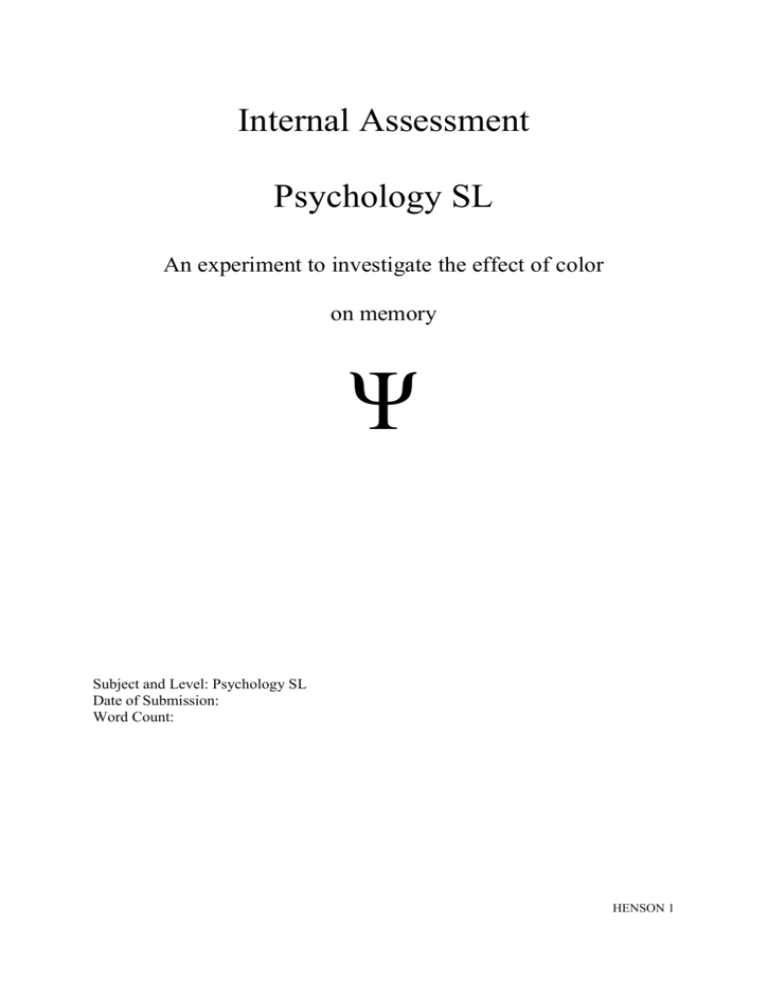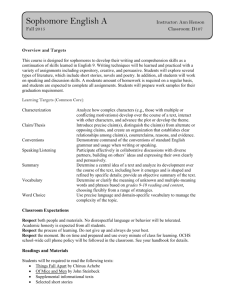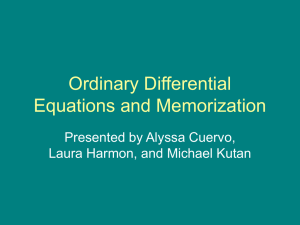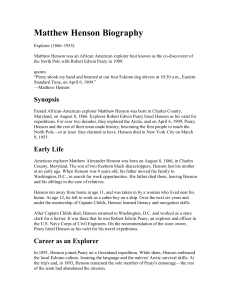Internal Assessment Psychology SL An experiment to investigate the
advertisement

Internal Assessment Psychology SL An experiment to investigate the effect of color on memory Ψ Subject and Level: Psychology SL Date of Submission: Word Count: HENSON 1 ABSTRACT The purpose of this experiment was to examine how color effect memorization. This experiment was originally done by Wendy M. Sleeth (2009), The Use of Color to Increase Memorization. The independent variable of this experiment was the color of the words, which were red and black, and dependent variable was the number of recalled words. This experiment focused on the cause and effect relationships. Independent measure design was used with opportunity sampling methodology. There were two groups of 9th grade high school students who ranged from 14 to 16 year-old. There were 17 males and 28 females. There were 22 students in Group 1 and 23 students in Group 2. Both groups were tested in same condition and were given to memorize same list of 20 words, but with different color of the words. Group 1 was tested with black words and Group 2 was tested with red words. Participants were asked to recalled 25 words that were on the list after looking it over for one minute. The result of this experiment corresponded to Sleeth (2009). The experiment showed a slight difference of memorization between two colors. HENSON 2 HENSON 3 INTRODUCTION Memory plays a great part in our life. It gives us ability to store, retain, and recall new or old information. However, memory can be affected many different ways. Thus, something simple as color can trigger one’s memory. It is widely known that different colors have different affects on people, and there have been numerous studies and researches on the relationship between color and behavior. In The Color of Learning (J. Myers 2004) describes that different colors have cause certain behaviors on human. He explains how colors cause one to trigger brain to release certain hormones and causes certain behaviors. For example, color red release hormones called adrenaline. Adrenaline is result of high stress and causes increase of heartbeats. Other colors like blue, triggers hormones that calm people. Colors also affect people’s arousal. G.D. Wilson (1966) experimented on twenty college students to investigate color’s affect on arousal. Students were asked to look at a slide show of two color; red, a warm color, and green, a cool color, while He use galvanic skin response to measure the participants’ arousal through the electrical conductivity of their skins. As a result, he found that students were more aroused when looking at warm color, red, than color green. This experiment supports Faber Birren (1950), which describes that warm colors cause more arousal than cool colors. Birren describes that warm colors are “advance in space” while cool colors are “recede in space”. Also, Roozendaal (2002) describes affect of arousal on memorization. He explains the increase of arousal causes increase of memorization. When people experiences arousal, hormones changes and causes increase on development of memmory. Wendy M. Sleeth (2009) states the relationship between color and memorization. She used single blind methodology with independent measure. 41 student of Missouri Western State College participated on her experiment and she divided them in three different groups. Her independent variable was the color of the word, red or black, and her dependent variable was the number of the words that were recalled from the students. She used list of 12 words and Group One was tested with black list of words, Group Two was tested with same list of words but in red, and Group three was also tested with the same list of words except half of the words were in black and the other half was in red. She tested on the cause-and-effect relationship between two colors. She was aiming to investigate if red would increase one’s memorization. This was supported by her result as she found. She found higher mean of number of the words recalled from Group two than the other groups. This showed a difference on the number of words recalled from red and black words. This experiment was to replicate Sleeth (2009). The aim of this experiment was to see if color effect memorization, and if it does, how do color affect one’s memorization. HENSON 4 METHOD DESIGN The methodology of this experiment is single blind experiment. Independent measure was used in this experiment. The independent variable was the color of the words. Color black and red was used as the color of the words. The dependent variable was the number of words that participants recalled. The words used were chosen to limit any relation one might have to another, i.e. car and wheels would not be included on the list because they are related to each other. Also, the words were assured that they did not have a clear colored image of the words, i.e. apple could not be used because it has a red colored image. Experimenters used the script (Appendix 2) to give out instruction to the participants. Participants had to have consent forms (Appendix 1) signed by the participant and their guardians. The consent forms were done to inform the participants about the experiment. Physical and emotional harm was avoided during the experiment and participants were capable to withdraw from the experiment. Also, results of the experiment remained confidential and participants were debriefed with the experiment. PARTICIPANTS By using opportunity sampling, 9th grade high school students, who range from 14 to 16 yearold, were the participants of this experiment. Opportunity sampling was convenient, available at the time, and it was easier to use with school schedule. However, this type of sampling can be very biased and unrepresentative since participants are chosen who will be helpful to the experiment. There were two groups; Group 1 was experimented with a list of black words and Group 2 was experimented with list of red words. There were 22 participants in Group; 12 males and 10 females; 14 fourteen year-old, 7 fifteen year-old, and 1 sixteen year-old. 23 participants were in Group 2; 5 males and 18 females; 18 fourteen year-old and 5 fifteen year-old. MATERIALS - Consent forms (Appendix 1) - Script (Appendix 2) - 2 Lists of 25 words (Appendix 4) One in Red and one in Black - Stop watch PROCECEDURES The experiment was done in a classroom under teacher’s supervision around 7:30 to 8:30 in the morning. Consent forms (Appendix 1), which were signed by the participants and their guardians, were collected before performing the experiments. Instructions were read directly off of the given script. (Appendix 2) The participants were reminded again with ethical guidelines; participants were permitted to withdraw during the experiment, they were informed that results of the experiments will stay confidential. They were also informed that it was a simple memory experiment. Participants were asked to clear their desks and take out a piece of paper and writing utensil. HENSON 5 Participants were asked to take few minutes to write down their name and gender on the top right corner of their paper and no other personal information. Participants were asked to remain quiet throughout the experiment. List of twenty-five black or red words (Appendix 4) were shown front of the classroom where all participants were able to see. Participants were given one minute to look over the words. The list of the words was taken down and participants were asked to write down as much as word they could recall on their piece of paper. After two minutes were passed, the papers that participants have written on were collected. When all the papers were collected from the participants, debriefing of the experiment was done. These procedures were repeated once more for the other group. RESULTS HENSON 6 In this experiment two groups received different condition of the test. Group 1 received Black words and their results, number of words that are recalled by participants, varied from 5 to 18 words. Group 2 received red words for the experiment and their result varied from 7 to 15. The range of Group 1, Black Word, was 13, and the range of Group 2, Red Words, was 8. The range of a data is difference between the maximum and minimum of the data. Standard deviation is found by using different statistic formula (Appendix 7). The standard deviation shows variation and the spread of the data. Standard deviation was used to relate the sample to the groups’ dispersion. Group that was tested with black words showed greater range and standard deviation than the group tested with red words. This show that group that was tested with black words were more dispersed than the group that was tested with red words. Black Words Red Words Range 13 8 StDev 2.82 2.39 Mean of the results, which is the average number of words recalled, are calculated by using the statistic formula (Appendix 6). The mean gives the measure of central tendency and the bar graph was used to compare and show the differences between the groups. Mean Black Red Words Words 10.14 10.17 The graph below shows the differences of the mean between the result black words and red words. Mean Difference: Black words vs. Red words 10.175 10.17 10.165 10.16 10.155 10.15 10.145 10.14 10.135 10.13 10.125 Mean Black Words Red Words The difference in the graph shows there were difference between red and black words. Students who were tested with red words had higher number of recalled words than students tested with black words. DISUSSION HENSON 7 This experiment supports Sleeth (2009) experiment. Like Sleeth (2009) there was difference on numbers of recalled words between red and black words. There was a little difference in the mean; red words resulted on higher mean on recalled words than the black words. This demonstrates, in average, students who were tested with the red words were able to recall more words that students who were tested with the black words. Therefore, colors had caused some impact on memorization. The strength of this experiment was the independent measure design. This type of design helped experimenters to avoid some cofounding variables. Since different groups were used, order effects, which are boredom, fatigue, and learning, were unlikely to affect the result. Demand characteristics were also less likely to influence the result, because different groups were used in each condition, it was less likely for participants to guess the aim of the experiment. Experimenters were able to use same list of words were used for both groups so both group received same level of words; one group did not receive harder list of words than the other. The experiment was done in same day and time of the day, so was able to face less confounding variables. On the other hand, the weakness of this experiment was that because it was independent measures and not repeated, there are differences of individual between two groups. Thus different characteristics of the individual, subject variable (i.e. gender, age, intelligence, etc.) is not kept constant. Moreover, this was not a field or natural experiment. Therefore, participants could have reacted differently to how they would have reacted in real life. To avoid these weaknesses, repeated measure could be used. So there would be one group that is tested with split list of words, half being black and other half being red. Overall, the experiment corresponds to Sleeth (2009). There were differences on number of recalled words between colors of the words. HENSON 8 REFERENCES Wendy M. Sleeth (2009) The Use of Color to Increase Memorization. Missouri Western State University. Myers, J. (2004). The color of learning. Fundamentals, Training and Development. February 2004, 19-20. G.D. Wilson (1966) Arousal properties of red versus green. Perceptual and Motor Skill Birren, F. (1950). Color psychology and color therapy. New York: McGraw-Hill. Roozendaal, B. (2002). Stress and memory: opposing effects of glucocorticoids on memory consolidation and memory retrieval. Neurobiology of Learning and Memory, 78, 578-596. APPENDICES HENSON 9 Appendix1 CONSENT FORM Researcher: Byeolah Henson I______________________________________, (Participant’s Name) give my consent and agree to participate in a simple memory experiment as a volunteer participant. I understand that I am giving consent for my results to be used in the experiment. I understand that participating in this experiment that my results will be kept completely confidential between the researcher (above), IB Psychology Instructor Mrs. Patterson, and the International Baccalaureate Internal Assessment panel. I understand that I can withdraw out of the experiment at any time and my results that will be dismissed. I also acknowledge that the experiment will not cause me any physical, emotional, or social harm. If I have any questions or concerns at any time before or during the experiment, I may contact Mrs. Patterson at 215-0054. Participant/Student Signature: _______________________________ Parent/Guardian Signature: __________________________________ Appendix2 SCRIPT Hello, My name is Byeolah Henson. Today I am going to perform a simple memory experiment. If anyone wants to withdraw from the experiment, you will not be penalized. Remember, your experiment result will be kept completely confidential. Please remain quiet throughout the presentation and if you have any questions please raise your hand and I will come to you. Please clear your desk and take out a pen or pencil. First, I will pass out a blank piece of paper. Please take couple minutes to write your gender and age on the top right hand corner. Do not write your name. Then after writing the information asked, turn over paper and do not write anything until I say so. In a little while I will display list of words on the board that you will look at. You will have one minute to look over this list of words. I will tell you when to start writing. Remember to remain quiet through this experiment. Start. (After one minute.) Stop. Now turn over your paper and begin to write down as many words as you can remember. You will have couple of minute to write the words down. (After one minute.) Stop writing. Turn over your paper. Now I will collect the paper from you. In this simple memory experiment, I have either given you a list of words in black or the same list of words in red. This study you participated in shows if color increases memorization. If the black words show more remembrance or the red words show more remembrance. Thank you for your cooperation and for participating in this experiment. Please do not share this information with other students, because it can cause false result and it will break the confidentiality. Appendix3 HENSON 10 Debriefing “In this simple memory experiment, I have either given you a list of words in black or the same list of words in red. This study you participated in shows if color increases memorization. If the black words show more remembrance or the red words show more remembrance. Thank you for your cooperation and for participating in this experiment. Please do not share this information with other students, because it can cause false result and it will break the confidentiality.” - It is the last paragraph of the script. Appendix4 List of words 1. Camera 2. Wallet 3. Lamp 4. Chair 5. Book 6. Car 7. Rug 8. Shell 9. Basket 10. Belt 11. Plug 12. Coupon 13. Receipt 14. Umbrella 15. Fork 16. Kite 17. Guitar 18. Badge 19. Crayon 20. Mailbox 21. Flower 22. Suitcase HENSON 11 23. Ship 24. Phone 25. Dress Appendix 4 Raw Data; experiment Group 1; Black Words Participant no. Number of words recalled 1 2 3 4 5 6 7 8 9 10 9 18 7 8 11 5 9 10 10 11 12 13 14 15 16 17 18 19 20 21 22 8 11 12 9 12 8 13 12 14 7 9 12 9 Appendix5 Raw Data; experimt Group 2; Red Words Participan no. Number of words recalled 1 2 3 4 5 6 7 8 9 10 11 12 13 14 15 16 17 18 19 20 21 22 23 14 11 15 10 7 12 15 11 8 8 10 10 11 9 9 7 11 9 10 12 7 Appedix6 Mean: μ = Σx / n Experimental Group1 (Black Words): Σx = 223 words, n = 22 participants 223 Mean = words = 10.13 words 22 Experimental Group 2 (Black): Σx = 234 words, n = 23 participants 234 Mean = words = 10.17 words 23 Mean percentage difference between Group 1 and Group 2: Appendix7 10.17 10.13 100 = 0.4% 10.13 2 Standard deviation: n 1 Standard deviation in experimental Group 1 (Black Words): 2.82 Standard deviation in experimental Group 2 (Red Words): 2.39 HENSON 12 7 11




